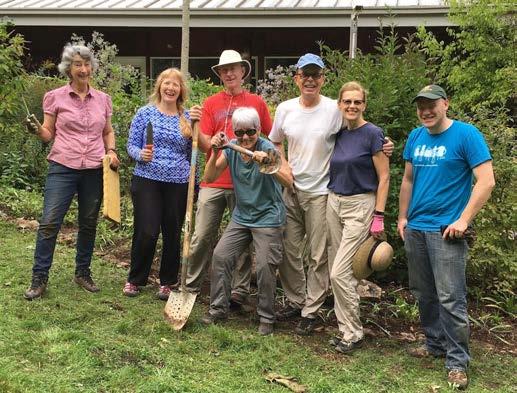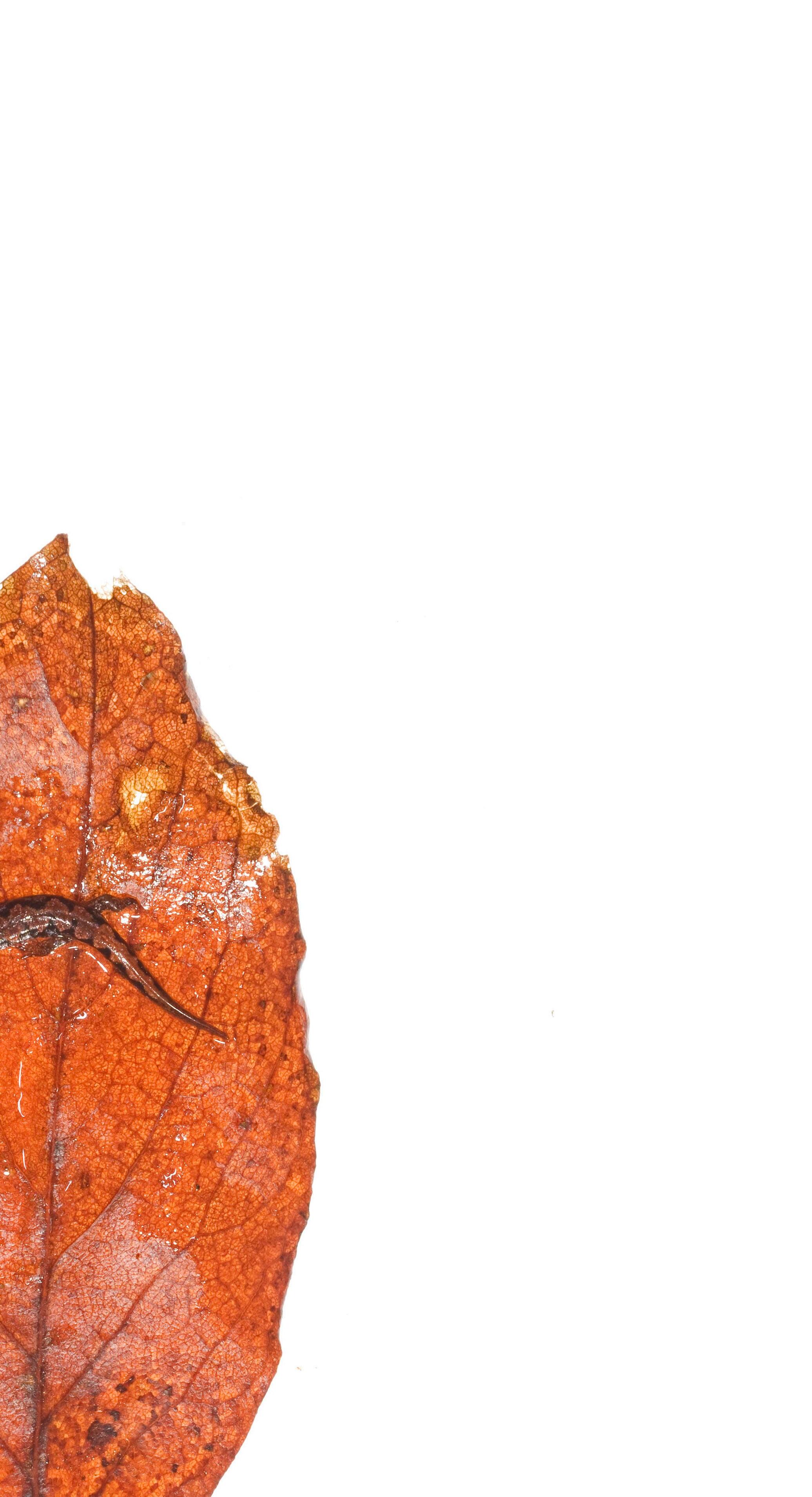CONSTRUCTION BEGINS ON THE NORTH CAMPUS PROJECT
Exciting things are happening on Lindenwood Lake! Within weeks we will begin construction on the North Campus project. Next summer we hope you will join us for a walk on the new boardwalk around the lake and bring your family for a picnic in the new John “Sto” Stowers lakeside teaching pavilion or stroll through the pollinator garden. Thanks to the contributions of hundreds of donors we are partnering with Bryson’s Grading & Paving and Tate Landscaping to turn the north campus of HBS into a new destination for our members, students and visitors to Highlands. One of the most alluring features of the HBS campus is beautiful Lindenwood Lake, yet many Highlands residents are unaware of this gem located just a few blocks off of Main Street. With this new project, we will encourage our visitors to discover this resource and invite them to learn more about native plants, pollinator species and the ecology of a mountain lake and bog.
We would like to extend a heartfelt thank you to all the donors who have given to the North Campus Improvement Campaign! With this project, we hope to create a space that honors all aspects of the Highlands Biological Station: the deep tradition of education, appreciation for the beauty and diversity of our native species, and the conservation and presence of habitat for flora and fauna.


THANK YOU GARDEN VOLUNTEERS!
A NOTE FROM HBF EXECUTIVE DIRECTOR, CHARLOTTE MUIR:

Thanks to our dedicated garden volunteers, the Botanical Garden has never looked better! This team met every Wednesday morning to assist HBS Horticulturist, Chan Chandler, with various projects including plant rescue and transplant, trail maintenance, and hardscaping.
As the leaves change and we enter a season of reflection and planning, I can only smile when I think of my first summer as the Executive Director of the Highlands Biological Foundation. The Station truly comes to life as the labs are full of students, the Garden is full of volunteers and hiking families, and the Nature Center is full of campers. We celebrated many successes in the summer of 2018 including standing-room-only Zahner lectures, soldout summer camps, record-setting fundraisers and immeasurable enthusiasm. Thanks to our membership, HBF sustains our mission to foster education and research focused on the rich natural heritage of the Highlands Plateau. Your contributions, time volunteering, and goodwill in our community have ensured our success this year. We look forward to seeing you in 2019, especially at the north campus!

Biological
265 N. 6th St. | P.O. Box 580, Highlands, N.C. 28741 (828) 526-2221 www.highlandsbiological.org
Highlands
Foundation
SCENES FROM HBF
ZAHNER CONSERVATION LECTURES


SUMMER INTERNSHIPS
FALL TRUSTEE MEETING

HBS hosted five interns over the summer – two worked in the Garden, two worked in the Nature Center, and one supported Foundation events.


Sarina Dellinger, Senior at UNC-Charlotte majoring in Biology, shares a bit about her experience below.
HALLOWEEN ENCHANTED FOREST


“I am so glad I was able to spend the summer as a Botanical Garden Assistant. I learned numerous native plants, gave garden tours, and worked alongside volunteers from the HBF Garden Committee. It was really nice to get hands-on experience in the garden. I also got to hike to Gregory Bald to see the hybrid azaleas in full bloom and to attend the Cullowhee Native Plant Conference for the first time. I even learned how to operate a chainsaw, string a weed eater, and drive a front-end loader! I gained so much knowledge from the HBS staff, and also so much confidence in myself and my abilities. From helping at Zahner lectures to weeding in the gardens, this summer was one that I will always remember.”

© HBF
2018 Summer Interns: Spencer Stone (NC State), Brett Ladrie (WCU), Brant Dupree (NC State), Cassie Skrutowski (NC State), Sarina Dellinger (UNC-Charlotte)
JULY 16 | SOIREE AT THE RABBIT HOLE
The Soiree at the Rabbit Hole, held at the historic home of Lisa & Clay Allen, in downtown Highlands, celebrated the success of the Highlands Biological Station over the past 90 years. Many thanks to our host committee: Tricia & Inman Allen, Judy & Dick Allison, Elizabeth Bradham, Martha & Michael Dupuis, Ruth & Berryman Edwards, Melinda & Jim Ethier, Cathy & Bob Fisher, Rachel Friday & Jeff Schenck, Monte & Palmer Gaillard, Anne & Dick Goodsell, Amanda & Greg Gregory, Julia & Bill Grumbles, Marianne & Bill Jenkins, Cathy & Paul Jones, Cookie & Harrison Jones, Carol & Stiles Kellett, Alfred Kennedy & Bill Kenny, Elizabeth & David Martin, Melanie & Tom Mauldin, Diane & Ray McPhail, Kathy & Jim Milby, Nancy & Lyle Nichols, Stephanie & Bill Reeves, Cheryl & Hugh Sargent, Martha & Hal Stibbs, Jennie Stowers, and Jane & Tom Tracy






OCTOBER 7 | HIGHLANDS ON THE HALF-SHELL


Highlands on the Half-Shell had a record crowd on a perfect sunny, Sunday afternoon! Thanks to everyone who attended to support the Highlands Biological Station, especially to our hosts: Lynda Anderson & Ken Conover, Hillary Cone, Kim & Bill Coward, Kim & Rich Daugherty, Vevie & Lawrence Dimmitt, Julia & Bill Grumbles, Diane & Michael Levine, Heath Massey & John Mitchener, Libbo & Gwaltney McCollum, Frances & Obie Oakley, Candy O’Gara, Ruthie & Frank Oliver, Karen Patterson, Miriam & Vernon Skiles, Marcia & Jack Stibbs, Martha & Hal Stibbs, Jennie Stowers, Jonnie & Jimmy Swann, Kathy & Bestor Ward, Lyda White & Art Steineker, and Sarah Morgan & Walter Wingfield



MEMBER-SUPPORTED RESEARCH GRANTS
For over 50 years, the Highlands Biological Foundation has provided grants in support of scientific research, bringing students to the Highlands Biological Station from all over the country and abroad. Through applications vetted by our Board of Scientific Advisors, these “Grants-in-Aid (GIA) of Research” make it possible for researchers to conduct their studies in residence at HBS and have supported thousands of research projects and hundreds of graduate theses and dissertations over the years. Their research has led to a better understanding of the incredible diversity of this region.
SIZE-CLASS DISTRIBUTION OF BLACK-BELLIED SALAMANDERS
PHILLIP GOULD
PHD STUDENT
THE OHIO STATE UNIVERISTY
In headwaters too shallow for fish and the terrestrial environments surrounding the headwaters, salamanders are the most abundant vertebrates, and important members of these ecosystems. Many of the salamander species inhabiting these streams are semi-aquatic; they live in or near water, and have completely aquatic larval stages. The black-bellied salamander is the largest and most common semi-aquatic salamander, therefore it is important to understand their role in these ecosystems’ dynamics. For example, larval salamanders are both predators of and prey for aquatic invertebrates.
I study the importance of semi-aquatic salamanders. In the summer of 2018, I used approximately 200 leaf litter traps to collect black-bellied salamander larvae at 43 stream sites to understand their distribution in streams. I also intensively surveyed 33 streams for adult black-bellied salamanders, building on previous work to describe their effects on the streams. Results from this work will improve our understanding of the salamanders’ contributions to nutrient cycling, aquatic ecosystem structure, and linkages between terrestrial and aquatic systems.

My collaborators and I also continued to examine the effects of the 2016 wildfires on salamander communities. Future projects include: examining salamander diet, nutrient excretion, and long-term effects of fire.
BREEDING PHENOLOGY OF ALTERNATIVE REPRODUCTIVE TACTICS IN THE BLUE RIDGE TWO-LINED
TODD PIERSON
 PHD STUDENT
PHD STUDENT
UNIVERSITY OF TENNESSEE-KNOXVILLE
Some organisms exhibit multiple, discrete reproductive tactics, often accompanied by differences in morphology. My colleagues and I study two of these alternative reproductive tactics in the Blue Ridge Two-lined Salamander (Eurycea wilderae)—a semi-aquatic, lungless salamander in the southern Appalachian Mountains. One male form has morphological traits suited for locating and courting females, and another has traits better suited for defending a nesting site from rival males. These two male forms coexist in many populations, but we still know relatively little about the origin of this variation or how it is maintained.
These salamanders are reproductively active from the fall through the spring, so this fall, I will be using several sampling and survey techniques to better elucidate differences in reproductive timing between these two male forms. These data will help us better understand the fitness consequences of each male strategy and plan future studies of the evolutionary dynamics of this study system.
In August, I spent a week at HBS scouting out my field sites and learning about courtship pheromones from Drs. Damien Wilburn and Rick and Pam Feldhoff.
SORTING OUT SALAMANDER COMMUNITIES
THOMAS RADOMSKI PHD STUDENT UNIVERSITY OF MINNESOTA - TWIN CITIES
An ever-pressing question in ecology and evolution is how species coexist given limited resources. Most ecological research has argued that species specialize on different resources, reducing competition and thus facilitating coexistence. However, some theories suggests that species may evolve to be more similar when they compete. Previous work on plethodontid salamanders of the southern Appalachians has suggested that they may have evolved to be extremely similar in body size.
My summer research focused on testing this theory. I accessed several field sites in western North Carolina with robust salamander communities. Sampling results from populations at geographically separate locations, seem to indicate that some of the observed variation in body size could be explained by location, which could change the conclusions of the previous work. Indeed, when applying this methodology, I found little evidence that salamanders grow to more similar sizes when they co-occur. Currently I am analyzing similar data from throughout eastern North America.
Prior to initiating my research, I took the “Biology of Southern Appalachian Salamanders” course at HBS taught by Drs. Ken Kozak and Joe Pechmann. The course gave me invaluable experience regarding field techniques, identification, and ecology.


HOW NOISE AFFECTS NOCTURNAL DEER MICE

RADMILA PETRIC PHD STUDENT UNC-GREENSBORO

Man-made (anthropogenic) noise is a pervasive global pollutant that negatively affects vocal communication in various species. Vocal communication is an essential component of animal behavior yet we know relatively little about the impact of audible or ultrasonic (highfrequency sounds that are above human hearing) noise on vocal signals of nocturnal animals.
Rodents play a crucial role in maintaining a healthy ecosystem by directly and indirectly influencing the abundance and distribution of other species. In order to better understand the effects of anthropogenic noise on vocal communication, my research focused on freeliving, nocturnal, and vocal rodents; the deer mouse (Peromyscus maniculatus) and woodland jumping mouse (Napaeozapus insignis). Specifically, the project focused on the effects of noise on foraging, exploration, and vocalizations.
I live-trapped mice, put radio-transmitters on individuals, recorded their vocalizations and measured their activity level. At night, when the mice were active, I experimentally broadcast noise and natural sounds in the territory of individual mice. To record vocalizations, and monitor movements and activity, I used three remote sensing systems: a microphone array, radiotelemetry tracking equipment, and thermal imaging cameras. My results suggest that in the presence of anthropogenic noise, deer mice spend less time foraging, exploring and vocalizing, whereas woodland jumping mice seem more tolerant of the noise.
© Clay Bolt | meetyourneighbours.net
LETTER FROM THE STATION DIRECTOR CATAMOUNTS IN HIGHLANDS!
JIM COSTA, EXECUTIVE DIRECTOR, HIGHLANDS
BIOLOGICAL STATION
Highlands Biological Station just concluded its 91st year, and what a year it’s been! Three major renovation/ construction projects, a record number of summer field courses and workshops, a thriving volunteer program, and more researchers than perhaps ever before on the HBS campus! The most momentous event in this momentous year was the cementing of the HBS-Western Carolina University (WCU) relationship: HBS moved fully under WCU’s umbrella this summer, 42 years after joining the UNC system! HBS has been closely associated with WCU for decades, but a recent memorandum of understanding between WCU, HBS, and the UNC System Office establishes our status as a member of the Catamount family, and creates new opportunities for all.
The road was long—and smooth for the most part. HBS started as a private non-profit research organization in 1927. Sited on the Blue Ridge Escarpment, it has a long tradition as a “base camp” for biologists from across the country and around the world. Why a biological station here, you ask? Because we are in one of the greatest temperate-zone biodiversity hotspots of the world, a region with tremendous species and habitat diversity that stems, in large part, from the Blue Ridge’s topographic diversity and abundant rainfall. Our part of the world boasts the highest mountains on the eastern side of North America, a vast and remarkably intact forest ecosystem, and for many groups of organisms (flowering plants, salamanders, fungi, crayfish, freshwater fish...) peak species diversity.
Field biology in the “back of beyond” is not alway seasy. Established when travel was difficult, HBS provided a base for biologists conducting research in the southern Appalachians, providing them labs, dorms, and equipment. Hundreds of graduate theses and dissertations and thousands of scientific papers have documented research conducted here.
From the start, HBS engendered strong public support and engagement, no doubt because some of our founders were community-minded local citizens deeply knowledgeable of local botany and zoology. One telling indication of that deep local tradition in natural history comes from the writer Bradford Torrey, who commented in an 1898 memoir, A World of Green Hills, that “Botany and Latin names might almost be said to be in the air at Highlands...the truth is that the region is most exceptionally rich in its flora, and the people, to their honor be it recorded, are equally exceptional in that they appreciate the fact.” The tradition of community engagement continues through extensive natural history programs and the native plant botanical garden, and soon with the addition of the north campus improvements.
In the mid-1970s HBS made its first transition, from private non-profit to an Inter-Institutional Center of the UNC system. The original non-profit was reorganized into the modern Highlands Biological Foundation, Inc. (HBF), with the mission of supporting the educational and research mission of HBS. Soon thereafter WCU became HBS’s administrator within the university system. Since then, the Station has grown via donated properties, additional laboratories and classrooms, more housing, dining facilities, a library, a herbarium, and more. Besides hosting summer researchers, HBS offers accredited field biology courses, in cooperation with WCU and UNC, and provides a diverse menu of courses and workshops for life-long learners. And so, counting down to our centennial, HBS is prepared to continue its long tradition of supporting academic research in our Southern Highlands, and in providing critical environmental education to residents and visitors.

© Clay Bolt | meetyourneighbours.net
NATURE CENTER NEWS


Summer 2018 was an incredible season for Highlands Nature Center. Increased camp offerings, weekly evening programs and lectures, and rotating exhibits kept staff, volunteers, and visitors engaged (and busy!) all summer long.

Summer camps at the Nature Center took new shape in 2018, expanding offerings for 4-6 year-olds and 7-9 yearolds and adding Junior Counselor volunteer opportunities for older youth. Our Education Specialist, Eliese Ronke, and talented Assistant Naturalist interns led younger campers through exciting adventures as Animal Ambassadors, Wild Survivors, and more. Older campers hiked beautiful trails throughout the region, camped overnight in the Botanical Garden, and created nature-inspired artwork. Our fantastic team of Junior Counselors gave back to the Nature Center through hard work and service, while gaining experience working with children and environmental education.


Exhibits and activities at the Nature Center continue to grow and change. New displays on Southern Appalachian geology, birds, mammals, and waterways all engage visitors in the unique and wonderful ecology of the Highlands Plateau. In the Kids’ Exploration Zone, new activities about trees and habitats offer younger visitors the opportunity to learn through play, and refurbishment of existing exhibits has added color and light to the improved space. Even more additions throughout the Nature Center are in the works, including rotating exhibits for next year and a display on invasive species.
As we enter Autumn and wind down for the year, Highlands Nature Center promises more exciting things to come—new camps, new exhibits, and new opportunities for visitors, youth, and members of our community to learn about and celebrate the natural beauty of Highlands!
HigHlands Biological Foundation


P.O. Box 580
Highlands, N.C. 28741
| meetyourneighbours.net
© Clay Bolt

























 PHD STUDENT
PHD STUDENT











